Simulation-Based Cost Analysis of Industrial Supply of Chips from Logging Residues and Small-Diameter Trees †
Abstract
:1. Introduction
2. Materials and Methods
2.1. General Description of the Model and Biomass Characteristics
2.2. Demand and Supply
2.3. Terminal Characteristics
2.4. Systems for Comminution and Transport to the Terminal or End-User
2.4.1. Description of Systems
2.4.2. Input Data
2.4.3. Working Shifts
2.5. Cost Calculation
2.6. Experimental Design
2.7. Sensitivity Analysis
2.8. Verification and Validation
3. Results
3.1. Main Results
3.2. Material Flows
3.3. Sensitivity Analysis
4. Discussion
5. Conclusions
Author Contributions
Funding
Acknowledgments
Conflicts of Interest
References
- Scarlat, N.; Dallemand, J.-F.; Monforti-Ferrario, F.; Nita, V. The role of biomass and bioenergy in a future bioeconomy: Policies and facts. Environ. Dev. 2015, 15, 3–34. [Google Scholar] [CrossRef]
- Berndes, G.; Abt, B.; Asikainen, A.; Cowie, A.; Dale, V.; Gustaf, E.; Lindner, M.; Marelli, L.; Paré, D.; Pingoud, K.; et al. Forest Biomass, Carbon Neutrality and Climate Change Mitigation; From Science to Policy 3; European Forest Institute (EFI): Joensuu, Finland, 2016; ISBN 978-952-5980-27-1; ISBN 978-952-5980-28-8. [Google Scholar]
- Winkel, G. Towards a Sustainable European Forest-Based Bioeconomy—Assessment and the Way Forward; What Science Can Tell Us 8; European Forest Institute (EFI): Bonn, Germany, 2017; p. 162. ISBN 978-952-5980-42-4. [Google Scholar]
- SP Processum. The Future Needs Green Alternatives– We Mean to Create Them; The Biorefinery of the Future; Processum Biorefinery Initiative AB: Örnsköldsvik, Sweden, 2016. [Google Scholar]
- Mantau, U.; Saal, U.; Prins, K.; Steierer, F.; Lindner, M.; Verkerk, H.; Eggers, J.; Leek, N.; Oldenburger, J.; Asikainen, A.; et al. EUwood – Real Potential for Changes in Growth and Use of EU Forests; Final Report; Centre of Wood Science, University of Hamburg: Hamburg, Germany, 2010. [Google Scholar]
- Fernandez-Lacruz, R.; Di Fulvio, F.; Bergström, D. Productivity and profitability of harvesting power line corridors for bioenergy. Silva. Fenn. 2013, 47. [Google Scholar] [CrossRef] [Green Version]
- Fernandez-Lacruz, R.; Bergström, D. Assessment of high-frequency technologies for determining the moisture content of comminuted solid wood fuels. Wood Mater. Sci. Eng. 2015, 11, 13–24. [Google Scholar] [CrossRef]
- Routa, J.; Asikainen, A.; Bjorheden, R.; Laitila, J.; Röser, D. Forest energy procurement: State of the art in Finland and Sweden. Wires Energy Environ. 2013, 2, 602–613. [Google Scholar] [CrossRef]
- Andersson, R.; Emanuelsson, U.; Ebenhard, T.; Eriksson, L.; Hansson, P.-A.; Hultåker, O.; Lind, T.; Nilsson, D.; Ståhl, G.; Forsberg, M.; et al. Sly – en Outnyttjad Energiresurs; Swedish Biodiversity Centre at Swedish University of Agricultural Sciences and Uppsala University: Uppsala, Sweden, 2016; ISBN 978-91-88083-10-4. [Google Scholar]
- Fernandez Lacruz, R. Improving Supply Chains for Logging Residues and Small-Diameter Trees in Sweden. Ph.D. Thesis, Department of Forest Biomaterials and Technology, Swedish University of Agricultural Sciences, Umeå, Sweden, 2019. Doctoral thesis no. 2019:44. Available online: https://pub.epsilon.slu.se/16161/ (accessed on 9 January 2019).
- Fernandez-Lacruz, R.; Bergström, D. Windrowing and fuel-chip quality of residual forest biomasses in northern Sweden. Int. J. Forest Eng. 2017, 28, 186–197. [Google Scholar] [CrossRef]
- Eliasson, L.; von Hofsten, H. Prestation och Bränsleförbrukning för en Stor Mobil Flishugg–Albach 2000 Diamant; Skogforsk: Uppsala, Sweden, 2017. [Google Scholar]
- Kuhmaier, M.; Erber, G. Research Trends in European Forest Fuel Supply Chains: A Review of the Last Ten Years (2007–2016) - Part Two: Comminution, Transport & Logistics. Croat. J. Eng. 2018, 39, 139–152. [Google Scholar]
- Wolfsmayr, U.J.; Rauch, P. The primary forest fuel supply chain: A literature review. Biomass Bioenergy 2014, 60, 203–221. [Google Scholar] [CrossRef]
- Gunnarsson, H. Supply Chain Optimization in the Forest Industry. Department of Mathematics; Linköpings universitet: Linköping, Sweden, 2007. [Google Scholar]
- Kanzian, C.; Holzleitner, F.; Stampfer, K.; Ashton, S. Regional Energy Wood Logistics—Optimizing Local Fuel Supply. Silva. Fenn. 2009, 43, 113–128. [Google Scholar] [CrossRef] [Green Version]
- Kons, K.; Bergström, D.; Eriksson, U.; Athanassiadis, D.; Nordfjell, T. Characteristics of Swedish forest biomass terminals for energy. Int. J. Forest Eng. 2014, 25, 238–246. [Google Scholar] [CrossRef]
- Kons, K. Management of Forest Biomass Terminals; Swedish University of Agricultural Sciencies, Forest Biomaterials and Technology: Umeå, Sweden, 2019. [Google Scholar]
- Eriksson, L.O.; Björheden, R. Optimal storing, transport and processing for a forest-fuel supplier. Eur. J. Oper. Res. 1989, 43, 26–33. [Google Scholar] [CrossRef]
- Virkkunen, M.; Kari, M.; Hankalin, V.; Nummelin, J. Solid Biomass Fuel Terminal Concepts and a Cost Analysis of a Satellite Terminal Concept; VTT Technical Research Centre of Finland: Espoo, Finland, 2015. [Google Scholar]
- Jirjis, R. Storage and drying of wood fuel. Biomass Bioenergy 1995, 9, 181–190. [Google Scholar] [CrossRef]
- Olsson, O.; Eriksson, A.; Sjöström, J.; Anerud, E. Keep that fire burning: Fuel supply risk management strategies of Swedish district heating plants and implications for energy security. Biomass Bioenergy 2016, 90, 70–77. [Google Scholar] [CrossRef]
- Johansson, S. Flödesstyrning av Biobränsle Till Kraftvärmeverk– En Fallstudie av Ryaverket; Department of Forest Products, Swedish University of Agricultural Sciences: Uppsala, Sweden, 2013. [Google Scholar]
- Bergström, D.; Matisons, M. Forest Refine, 2012–2014: Efficient Forest Biomass Supply Chain Management for Biorefineries—Synthesis Report; Department of Forest Biomaterials and Technology, Swedish University of Agricultural Sciences: Umeå, Sweden, 2014. [Google Scholar]
- Erlandsson, E. The Triad Perspective on Business Models for Wood Harvesting Tailoring for Service Satisfaction within Forest Owners Associations; Department of Forest Biomaterials and Technology, Swedish University of Agricultural Sciences: Umeå, Sweden, 2016. [Google Scholar]
- Swedish Forest Agency. Lager av Barrsågtimmer, Massaved och Massaflis; Swedish Forest Agency: Jonkoping, Sweden, 2018.
- Raitila, J.; Korpinen, O.-J. The Concept of Terminal in the Supply Chain; Sikanen, L., Korpinen, O.-J., Tornberg, J., Saarentaus, T., Leppänen, K., Jahkonen, M., Eds.; Natural Resources Institute Finland: Helsinki, Finland, 2016. [Google Scholar]
- Tahvanainen, T.; Anttila, P. Supply chain cost analysis of long-distance transportation of energy wood in Finland. Biomass Bioenergy 2011, 35, 3360–3375. [Google Scholar] [CrossRef]
- Ranta, T.; Korpinen, O.-J.; Jäppinen, E.; Karttunen, K. Forest Biomass Availability Analysis and Large-Scale Supply Options. Open J. Forest 2012, 2, 33–40. [Google Scholar] [CrossRef] [Green Version]
- Palander, T.S.; Voutilainen, J.J. Modelling fuel terminals for supplying a combined heat and power (CHP) plant with forest biomass in Finland. Biosyst. Eng. 2013, 114, 135–145. [Google Scholar] [CrossRef]
- Virkkunen, M.; Raitila, J.; Korpinen, O.-J. Cost analysis of a satellite terminal for forest fuel supply in Finland. Scand. J. Forest Res. 2016, 31, 175–182. [Google Scholar] [CrossRef]
- Banks, J.; Carson, J.; Nelson, B.; Nicol, D. Discrete-Event System Simulation, 5th ed.; International version; Pearson Education: Upper Saddle River, NJ, USA, 2010. [Google Scholar]
- Aalto, M. Agent-Based Modeling as Part of Biomass Supply System Research; Lappeenranta-Lahti University of Technology: Lappeenranta, Finland, 2019. [Google Scholar]
- Kogler, C.; Rauch, P. Discrete event simulation of multimodal and unimodal transportation in the wood supply chain: A literature review. Silva. Fenn. 2018, 52. [Google Scholar] [CrossRef]
- Asikainen, A. Chipping terminal logistics. Scand. J. Forest Res. 1998, 13, 386–392. [Google Scholar] [CrossRef]
- She, J.; Chung, W.; Kim, D. Discrete-Event Simulation of Ground-Based Timber Harvesting Operations. Forests 2018, 9, 683. [Google Scholar] [CrossRef] [Green Version]
- Eriksson, A. Improving the Efficiency of Forest Fuel Supply Chains; Department of Energy and Technology, Swedish University of Agricultural Sciences: Uppsala, Sweden, 2016. [Google Scholar]
- Karttunen, K.; Lättilä, L.; Korpinen, O.-J.; Ranta, T. Cost-efficiency of intermodal container supply chain for forest chips. Silva. Fenn. 2013, 47. [Google Scholar] [CrossRef] [Green Version]
- Belbo, H.; Talbot, B. Systems Analysis of Ten Supply Chains for Whole Tree Chips. Forests 2014, 5, 2084–2105. [Google Scholar] [CrossRef] [Green Version]
- Väätäinen, K.; Prinz, R.; Malinen, J.; Laitila, J.; Sikanen, L. Alternative operation models for using a feed-in terminal as a part of the forest chip supply system for a CHP plant. Gcb Bioenergy 2017, 9, 1657–1673. [Google Scholar] [CrossRef] [Green Version]
- Fernandez-Lacruz, R. Supply Chain Simulation. Available online: https://youtu.be/PSmoPRMh3tY (accessed on 5 April 2019).
- Rivera, J. Modeling with Extend; IEEE Computer Society Press: Washington, DC, USA, 1998; pp. 257–262. [Google Scholar]
- Geer Mountain Software. Stat::Fit® Version 3. Distribution Fitting Software. Available online: https://www.geerms.com/Fitting-Distributions.html (accessed on 5 December 2019).
- Nilsson, D.; Thörnqvist, T. Lagring av Flisad Grot Vid värmeverk: En Jämförande Studie Mellan Vinter och Sommar Förhållanden; Faculty of Technology, Linnaeus University: Växjö, Sweden, 2013. [Google Scholar]
- Hansson, E. Metoder För att Minska Kapitalbindningen i Stora Enso Bioenergis Terminallager; Department of Forest Products, Swedish University of Agricultural Sciences: Uppsala, Sweden, 2010. [Google Scholar]
- Asmoarp, V. Terminalstrategier För Skogsflis på Södra Skogsenergi; Department of Forest Resource Management, Swedish University of Agricultural Sciences: Umeå, Sweden, 2013. [Google Scholar]
- Jönsson, P. Hjula eller traila? Kalkylverktyg [Drive or use trailer? Calculation tool]. Available online: https://www.skogforsk.se/kunskap/kunskapsbanken/2012/hjula-eller-traila/ (accessed on 9 December 2019).
- Bergström, D.; Fernandez-Lacruz, R.; Forsman, M.; Lundbäck, J.; Nilsson, Å.; Bredberg, C. Skog, Klimat och Miljö – Ett Projekt i Norr- och Västerbotten 2012–2014; Länsstyrelsen Västerbotten: Umeå, Sweden, 2015; p. 48. [Google Scholar]
- Eliasson, L.; Picchi, G. Huggbilar Med Lastväxlare Och Containrar; Skogforsk: Uppsala, Sweden, 2010. [Google Scholar]
- Andersson, R. Tidsstudie av Containerhuggbil; Department of Forest Resource Management, Swedish University of Agricultural Sciences: Umeå, Sweden, 2011. [Google Scholar]
- Spinelli, R.; Visser, R.J.M. Analyzing and estimating delays in wood chipping operations. Biomass Bioenergy 2009, 33, 429–433. [Google Scholar] [CrossRef]
- Von Hofsten, H.; Lundström, H.; Nordén, B.; Thor, M. Systemanalys För Uttag av Skogsbränsle - Ett Verktyg för Fortsatt Utveckling (FLIS); Skogforsk: Uppsala, Sweden, 2006. [Google Scholar]
- Ranta, T.; Rinne, S. The profitability of transporting uncomminuted raw materials in Finland. Biomass Bioenergy 2006, 30, 231–237. [Google Scholar] [CrossRef]
- Eriksson, A.; Eliasson, L.; Jirjis, R. Simulation-based evaluation of supply chains for stump fuel. Int. J. Forest Eng. 2014, 25, 23–36. [Google Scholar] [CrossRef]
- Asmoarp, V.; Enström, J.; Bergqvist, M.; von Hofsten, H. Effektivare Transporter på Väg. Slutrapport För Projekt ETT 2014–2016; Skogforsk: Uppsala, Sweden, 2018. [Google Scholar]
- Nylinder, M.; Kockum, F. WeCalc – Räkna på Skogsbränsle [WeCalc - forest fuel calculator]; Skogforsk: Uppsala, Sweden, 2016. [Google Scholar]
- Liss, J.-E. Studier på Nytt Fordon För Transport av Skogsflis; Institutionen för matematik, naturvetenskap och teknik, Högskolan Dalarna: Garpenberg, Sweden, 2006. [Google Scholar]
- Väätäinen, K.; Asikainen, A.; Eronen, J. Improving the Logistics of Biofuel Reception at the Power Plant of Kuopio City. Int. J. Forest Eng. 2005, 16, 51–64. [Google Scholar] [CrossRef]
- Aalto, M.; Korpinen, O.-J.; Loukola, J.; Ranta, T. Achieving a smooth flow of fuel deliveries by truck to an urban biomass power plant in Helsinki, Finland – an agent-based simulation approach. Int. J. Forest Eng. 2018, 29, 21–30. [Google Scholar] [CrossRef]
- Miyata, E. Determining Fixed and Operating Costs of Logging Equipment; General Technical Report NC-55; U.S. Dept. of Agriculture, Forest Service, North Central Forest Experiment Station: St. Paul, MN, USA, 1980.
- Brinker, R.W.; Kinard, J.; Rummer, B.; Lanford, B. Machine Rates for Selected Forest Harvesting Machines; United States Department of Agriculture: Washington, DC, USA, 2002; Volume Circular, p. 29.
- Balci, O. Validation, verification, and testing techniques throughout the life cycle of a simulation study. Ann. Oper. Res. 1994, 53, 121–173. [Google Scholar] [CrossRef] [Green Version]
- Dahlin, B.; Fjeld, D. OPERATIONS | Logistics in Forest Operations. In Encyclopedia of Forest Sciences; Burley, J., Ed.; Elsevier: Oxford, UK, 2004; pp. 645–649. [Google Scholar]
- Energy Companies Sweden (Energiföretagen Sverige). Tillförd energi till kraftvärme och fjärrvärmeproduktion och fjärrvärmeleveranser [Supplied energy to combined heat and power and district heating production and district heating supply]. Available online: https://www.energiforetagen.se/statistik/fjarrvarmestatistik/tillford-energi/ (accessed on 2 January 2018).
- Röser, D. Operational Efficiency of Forest Energy Supply Chains in Different Operational Environments; School of Forest Sciences, Faculty of Science and Forestry, University of Eastern Finland: Joensuu, Finland, 2012. [Google Scholar]
- Korpinen, O.-J.; Aalto, M. Assessing the Performance of Biomass Terminals and Supply Systems with Simulation Approaches; Natural Resources Institute Finland: Helsinki, Finland, 2016. [Google Scholar]
- Anerud, E.; Jirjis, R.; Larsson, G.; Eliasson, L. Fuel quality of stored wood chips – Influence of semi-permeable covering material. Appl. Energy 2018, 231, 628–634. [Google Scholar] [CrossRef]
- Eriksson, A.; Eliasson, L.; Hansson, P.-A.; Jirjis, R. Effects of Supply Chain Strategy on Stump Fuel Cost: A Simulation Approach. Int. J. Forest Res. 2014, 2014, 11. [Google Scholar] [CrossRef] [Green Version]
- Davidsson, A.; Asmoarp, V. Skogsbrukets Vägtransporter 2016; En Nulägesbeskrivning av Flöden av Biomassa från skog till industri; Skogforsk: Uppsala, Sweden, 2019. [Google Scholar]
- Eriksson, A.; Eliasson, L.; Sikanen, L.; Hansson, P.-A.; Jirjis, R. Evaluation of delivery strategies for forest fuels applying a model for Weather-driven Analysis of Forest Fuel Systems (WAFFS). Appl. Energy 2017, 188, 420–430. [Google Scholar] [CrossRef]
- Acuna, M.; Anttila, P.; Sikanen, L.; Prinz, R.; Asikainen, A. Predicting and Controlling Moisture Content to Optimise Forest Biomass Logistics. Croat. J. Eng. 2012, 33, 225–238. [Google Scholar]
- Di Fulvio, F.; Bergström, D. Analyses of a single-machine system for harvesting pulpwood and/or energy-wood in early thinnings. Int. J. Forest Eng. 2013, 24, 2–15. [Google Scholar] [CrossRef]
- Björklund, L.; Fryk, H. Mätning av Trädbränslen; VMF: Sundsvall, Sweden, 2014. [Google Scholar]
- Von Hofsten, H. Vägning av Hela Fordonslass − Möjligheter Och Felkällor; Skogforsk: Uppsala, Sweden, 2018. [Google Scholar]
- Fridh, L.; Eliasson, L.; Bergström, D. Precision and accuracy in moisture content determination of wood fuel chips using a handheld electric capacitance moisture meter. Silva. Fenn. 2018, 52. [Google Scholar] [CrossRef]
- Prinz, R.; Väätäinen, K.; Laitila, J.; Sikanen, L.; Asikainen, A. Analysis of energy efficiency of forest chip supply systems using discrete-event simulation. Appl. Energy 2019, 235, 1369–1380. [Google Scholar] [CrossRef]
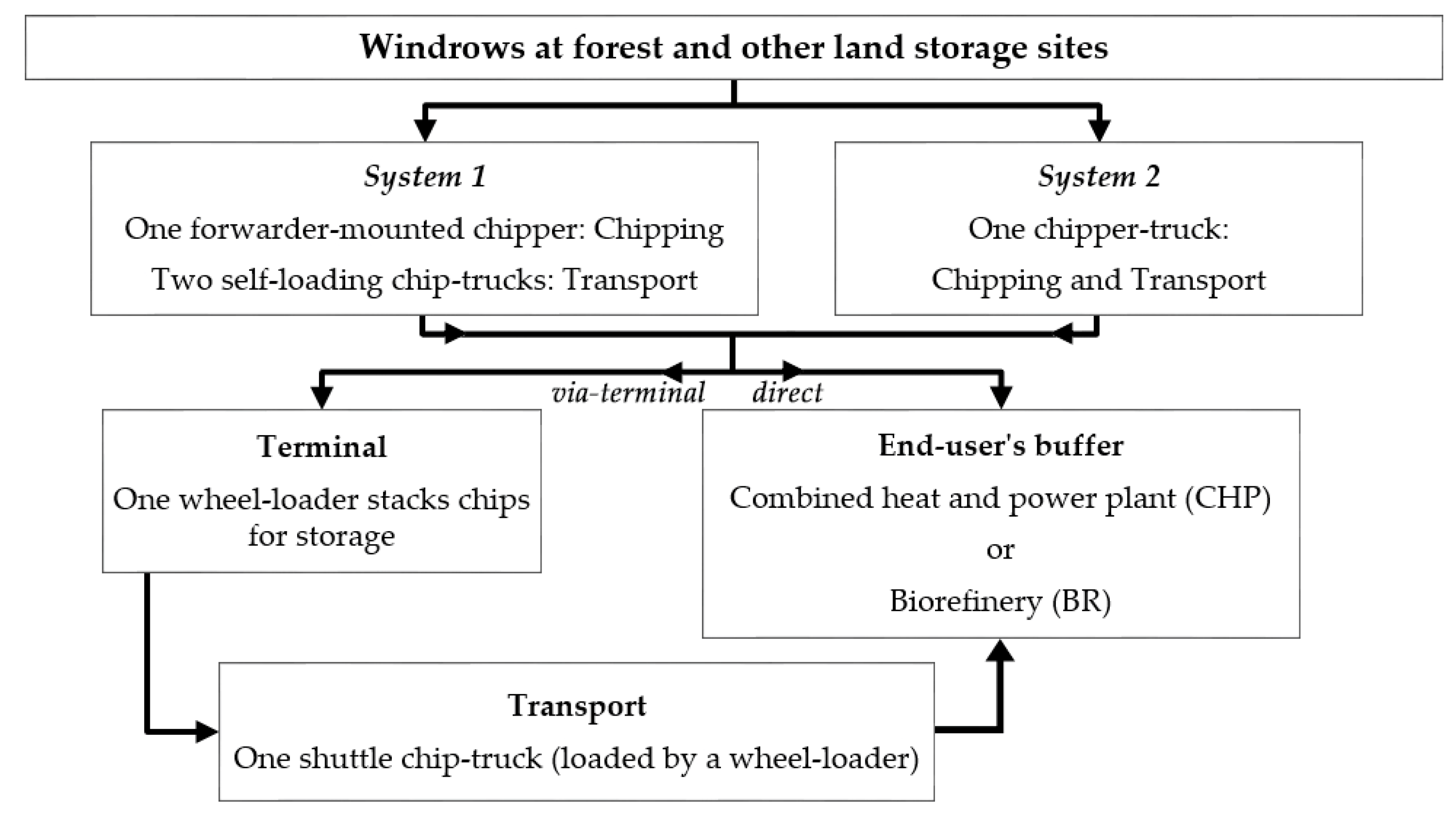
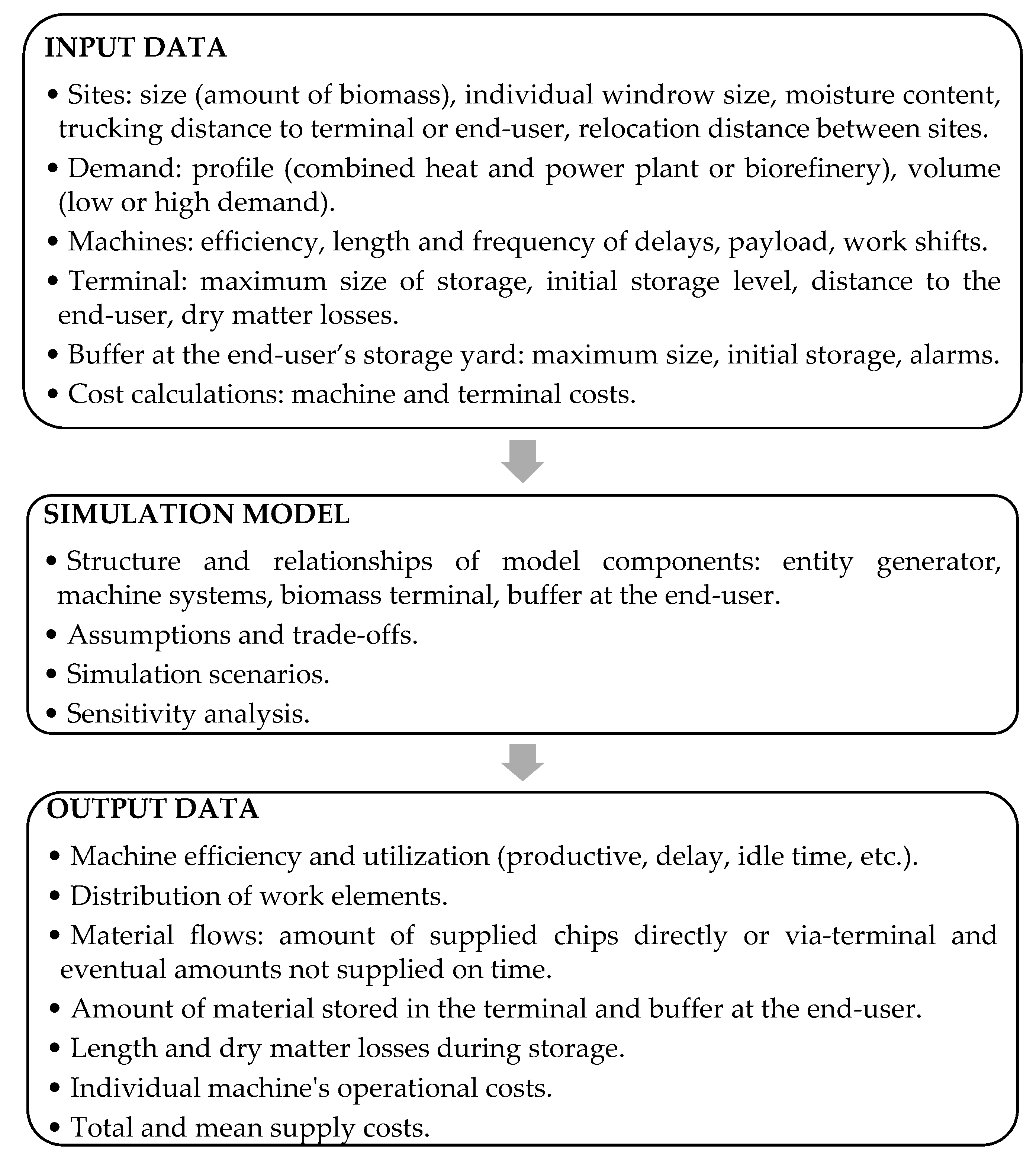

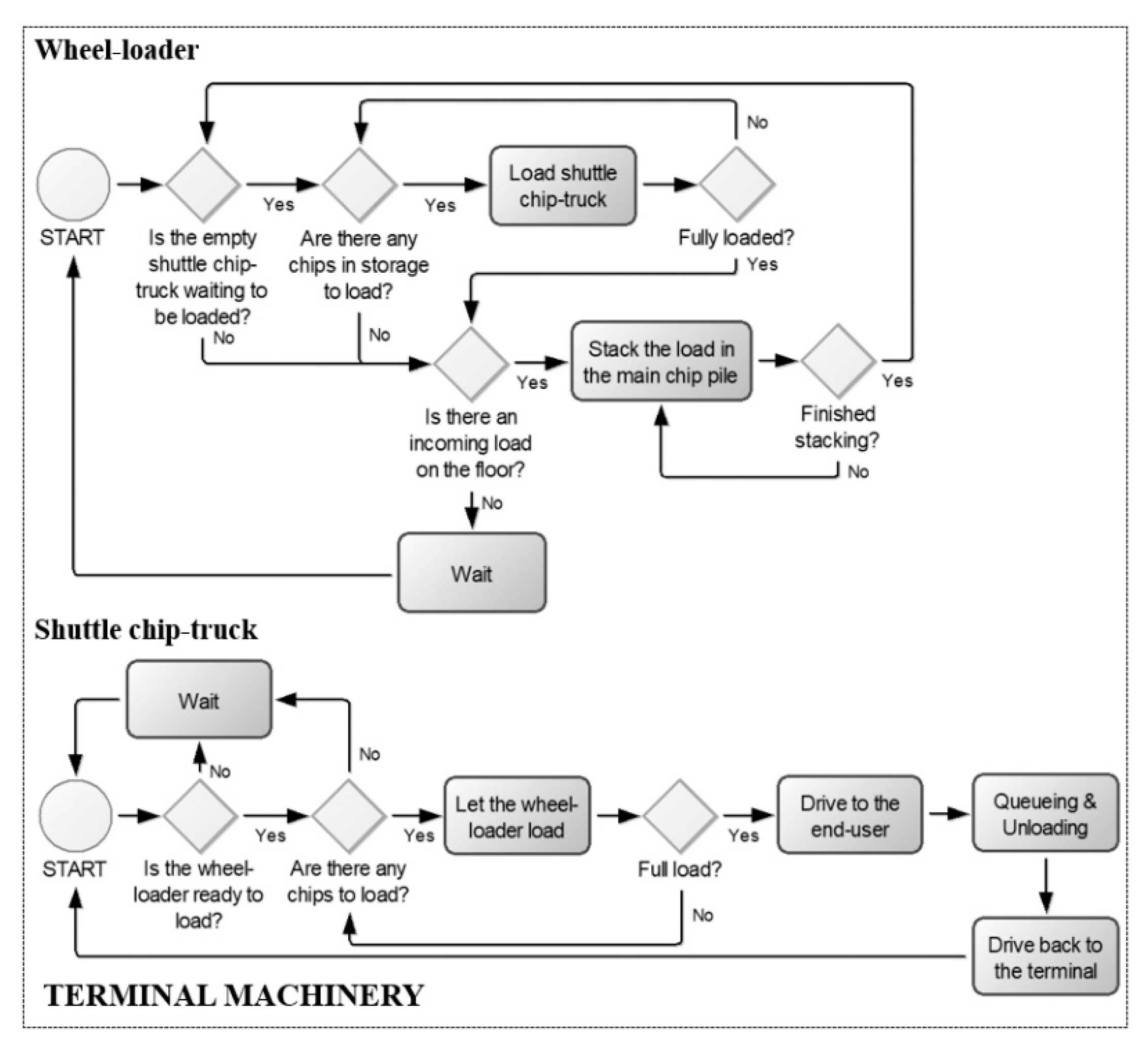
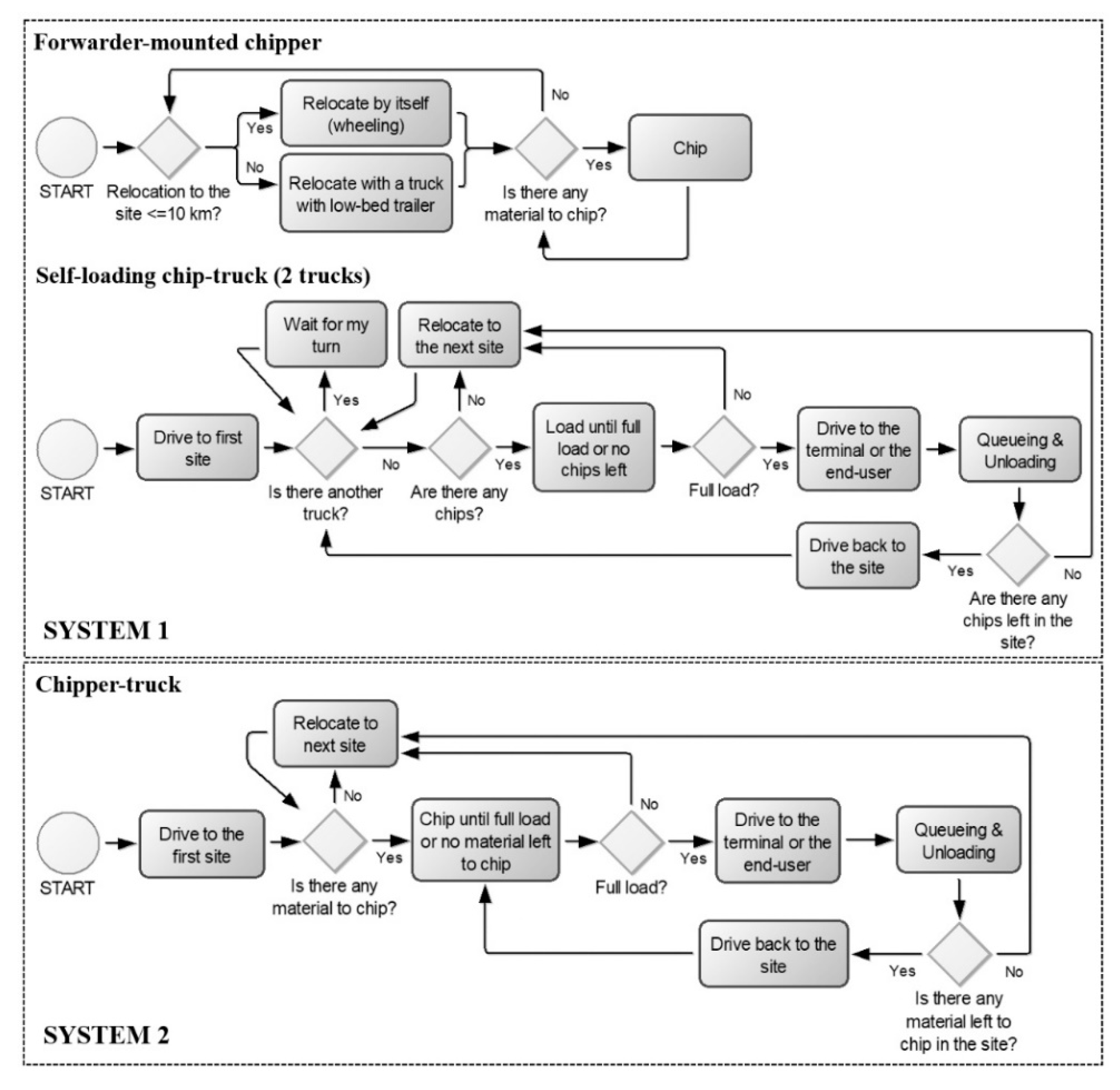
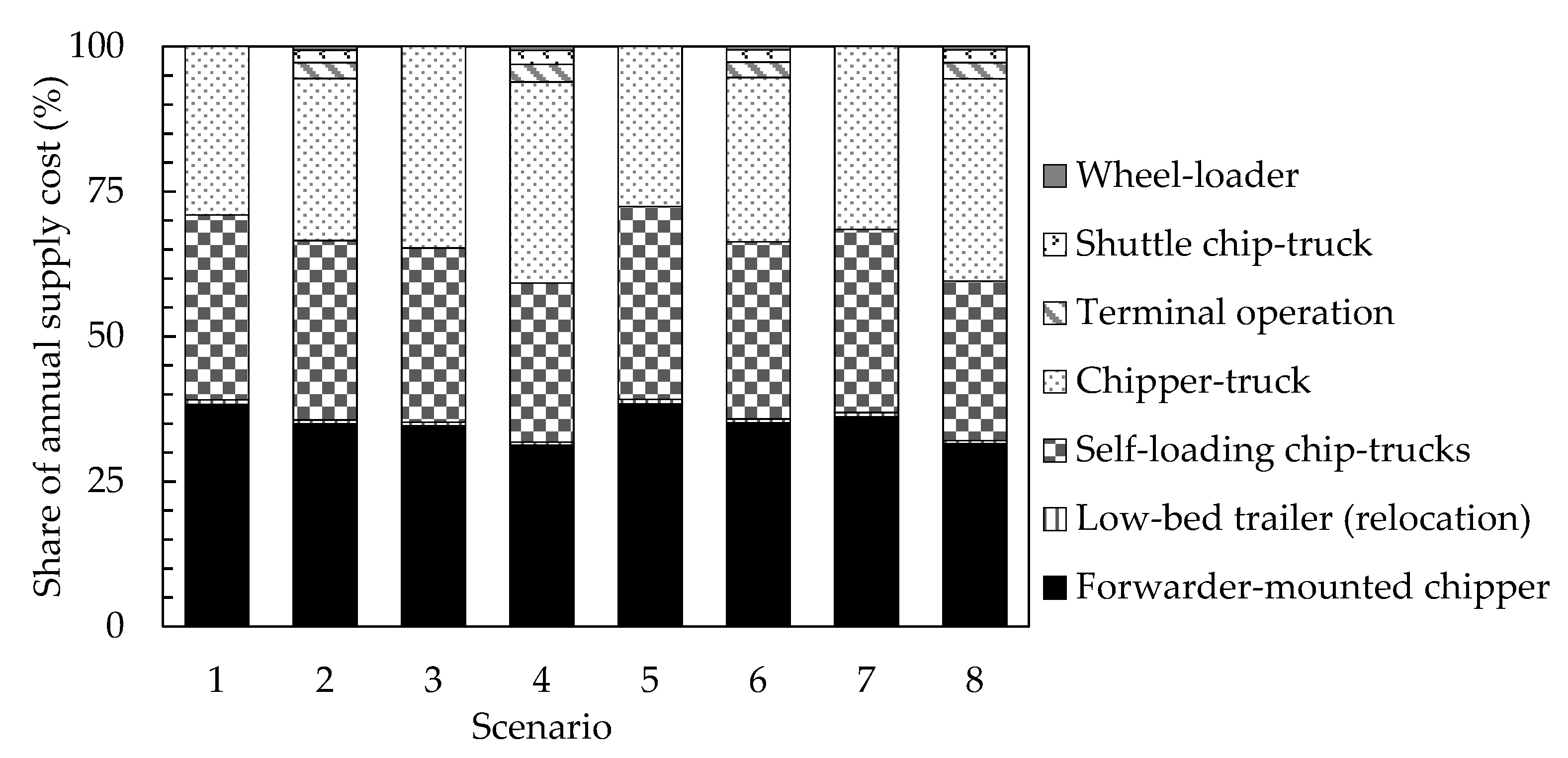
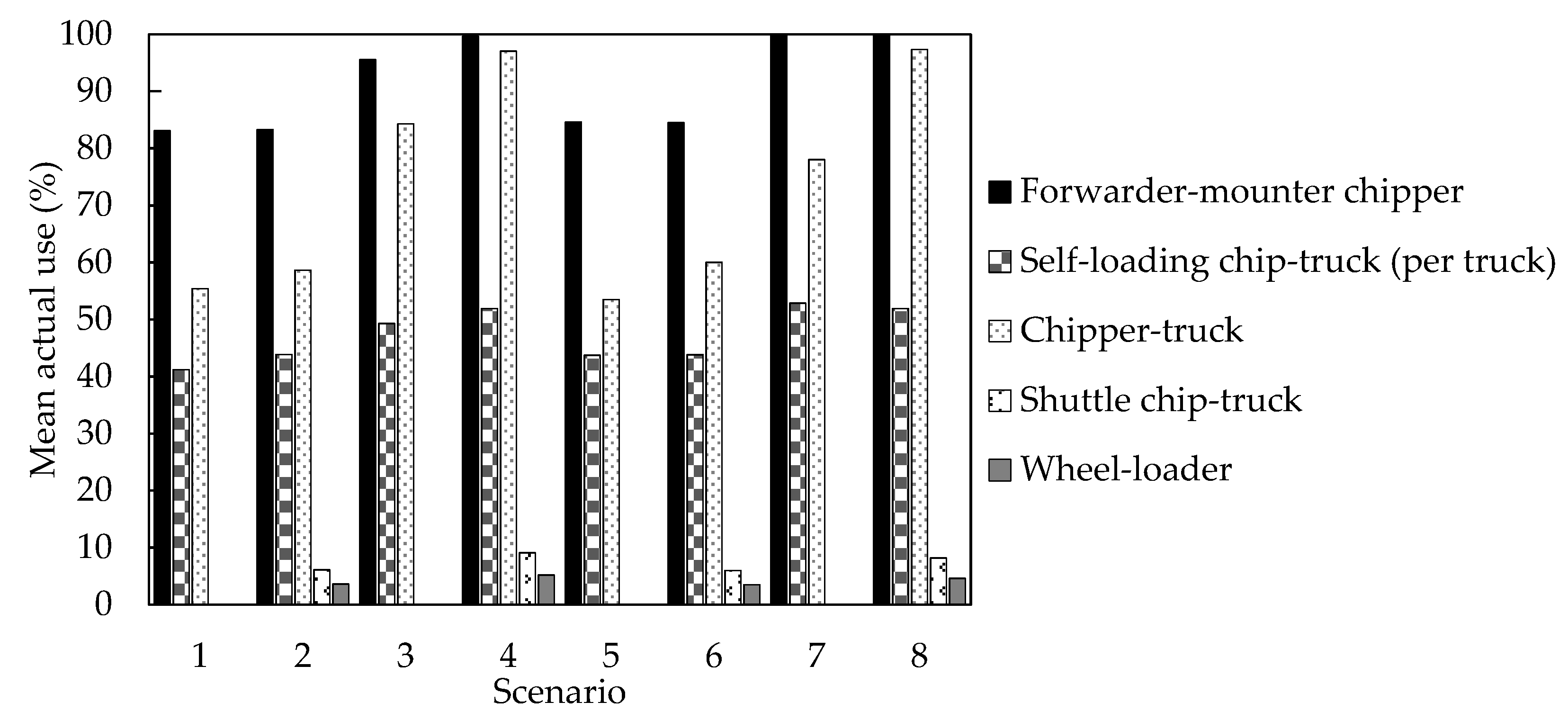

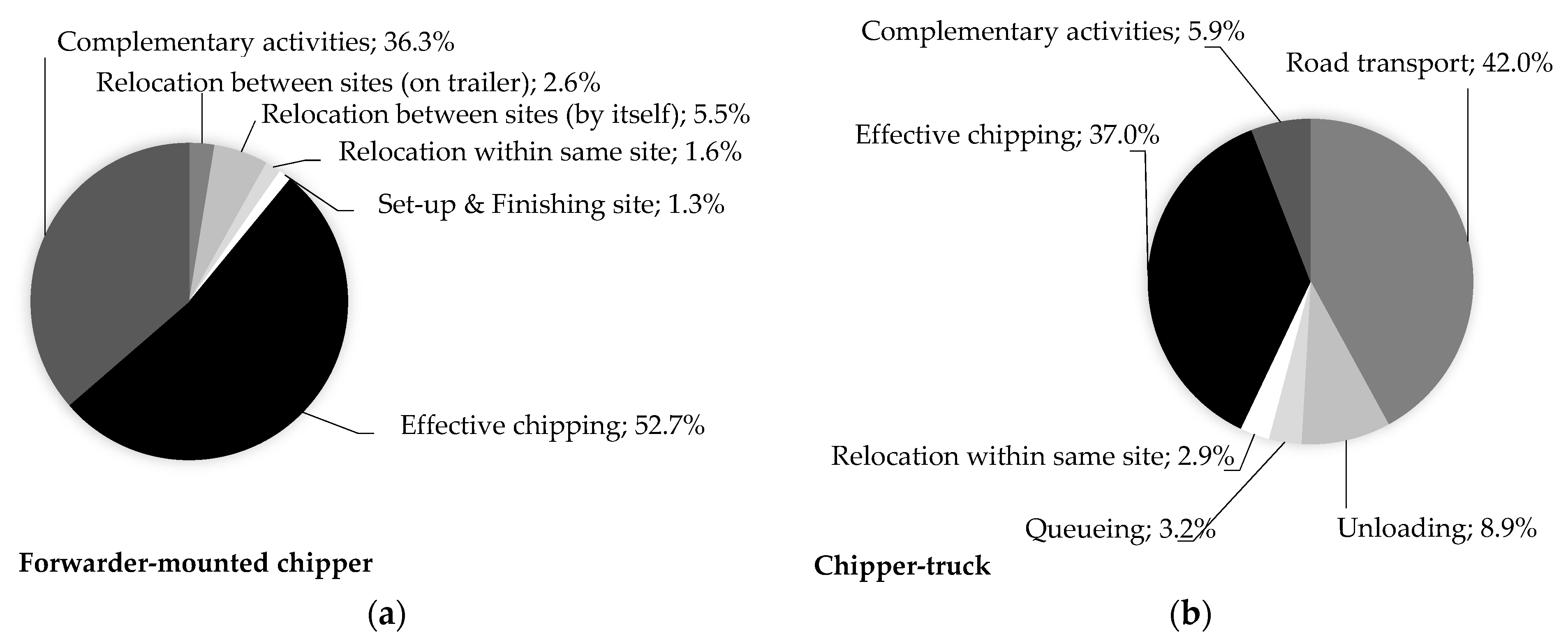
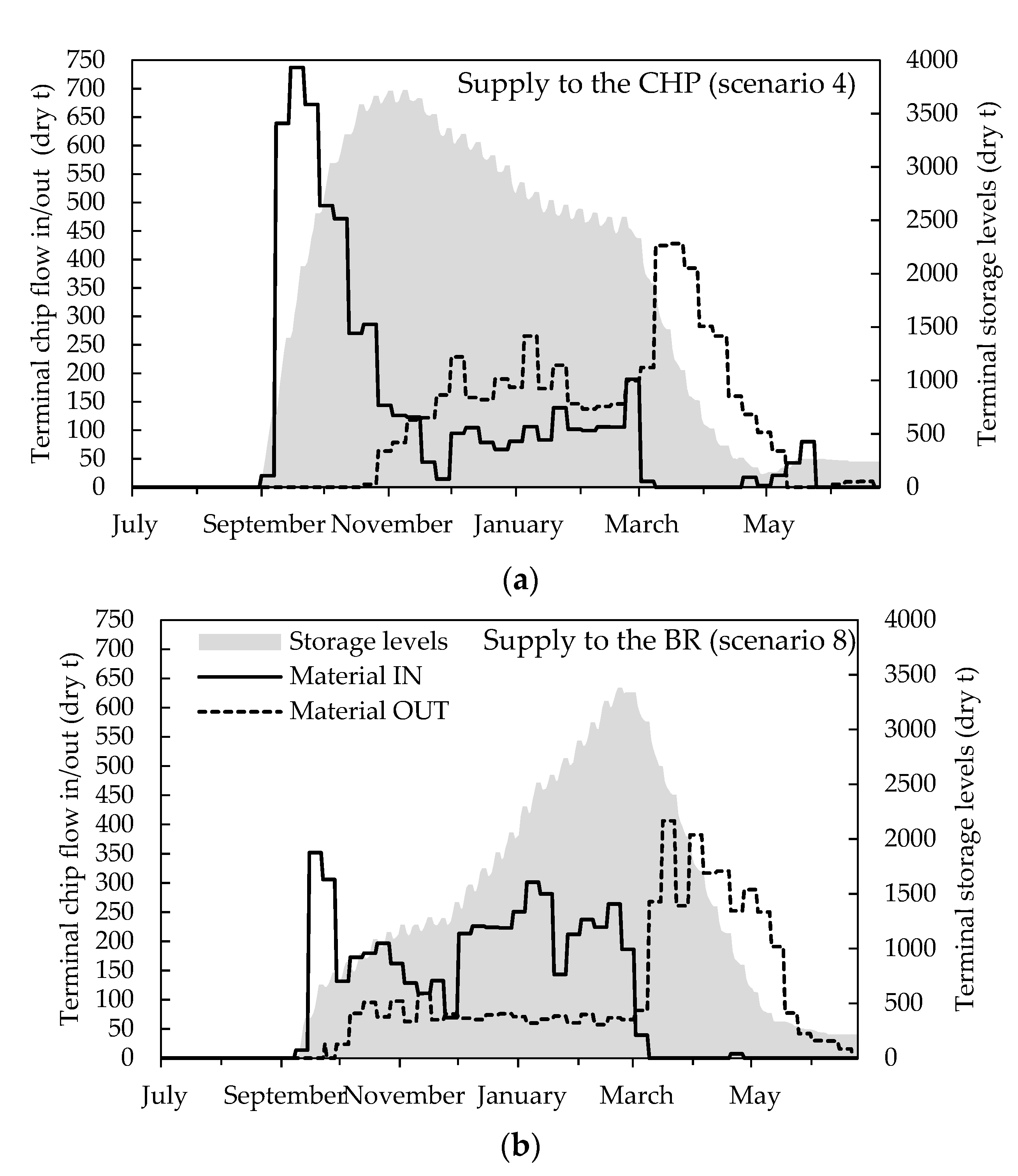
| Attributes | Unit | Distribution | 95% of Values between |
|---|---|---|---|
| Site size 1 | dry t | Gamma (12, 1.53, 44.6) 2 | 42–88 |
| Individual windrow size | dry t | Gamma (12, 3.43, 10.9) 3 | 30–55 |
| Moisture content (MC) | % | Triangular (26, 45, 61) 4 | 44–48 |
| Trucking distance from sites to the terminal or end-user 5 | |||
| May-November | km | Triangular (40, 49, 99) 4 | 45–54 |
| December-April | km | Triangular (4, 27, 35) 4 | 20–29 |
| Relocation distance between sites 6 | km | Beta (0.10, 68, 0.56, 4.83) 7 | 5–15 |
| Work Element | Unit | Description and Distribution | |
|---|---|---|---|
| Forwarder-Mounted Chipper | Chipper-Truck | ||
| Set-up at site | min | After relocation to new site: unload chains, tracks, portable wooden bridge and a log. | − |
| Triangular (2, 3, 6) 1 | |||
| Finishing site | min | Before relocation to new site: loading of elements in set-up. If road damages, the ground was flattened with a log and forwarder’s front-mounted shovel. | − |
| Triangular (2, 3, 6) 1 | |||
| Chipping | min dry t 1 | Chipping including crane work. | Chipping including crane work. |
| Triangular (2.3, 4.1, 6.1) 1 | Triangular (3.2, 4.8, 6.2) 1 | ||
| Complementary activities to chipping | min dry t 1 | Comprises terrain driving empty/full between the windrow-tipping point at the roadside and along the windrow, tipping over the chip-bin, engine start/shutdownometimes compaction of a snow surface for tipping chips over. | Comprises preparations: the driver changing cabin, eventual relocation along the windrow and engine start/shutdown. |
| Triangular (0.8, 2.0, 5.7) 1 | Triangular (0.6, 0.7, 0.9) 1 | ||
| Terrain driving for relocation within the site | min | Number of windrows: 2–6: Power Function (0,50, 0.77) 2 ≥7: Power Function (0,75, 0.77) 2 | Number of windrows: 2–6: Power Function (0,22, 0.77) 2 ≥7: Power Function (0,34, 0.77) 2 |
| Variable | Unit | Chipper-Truck | Self-Loading Chip-Truck | Shuttle Chip-Truck |
|---|---|---|---|---|
| Cargo volume | m3 | 102 | 120 | 140 |
| Tare weight | tonnes | 33 | 30 | 22 |
| Payload | tonnes | 31 | 34 | 42 |
| Break-even moisture content (MC) | % | 46.1 | 42.6 | 45.8 |
| Work element | ||||
| Loading | min | − | Triangular (41, 53, 65) 1 | − |
| Unloading (incl. load measurement and MC sampling) | min | Triangular (14, 18, 23) 1 | Triangular (14, 18, 23) 1 | Triangular (14, 18, 23) 1 |
| Machine | Investment k€ | Useful life of Asset Years | Utilization Rate % | Cost € SMh−1 |
|---|---|---|---|---|
| Forwarder-mounted chipper | 547 | 5 | 89 | 159 |
| Chipper-truck | 640 | 5 | 95 | 181 |
| Self-loading chip-truck + trailer | 458 | 7 | 100 | 133 |
| Shuttle chip-truck + trailer | 372 | 7 | 100 | 119 |
| Wheel-loader | 208 | 5 | 95 | 55 |
| Variable | Unit | Value |
|---|---|---|
| Total terminal area | ha | 2 |
| Area devoted to storage | % | 90 |
| Area paved | % | 100 |
| Purchase price of land | € m−2 | 0.5 |
| Gravel paved cost | € m−2 | 30 |
| Depreciation time | year | 15 |
| Interest rate | % | 5.5 |
| Space utilization | dry t m−2 | 0.78 |
| Material turnover | times per year | 1.5 |
| Operational cost | € dry t−1 | 8.3 |
| End-User | Demand Volume | Supply Alternative | Scenario |
|---|---|---|---|
| Combined heat and power plant (CHP) | Low (21,000 dry t) | Direct (only) | 1 |
| Combined (direct and via-terminal) | 2 | ||
| High (29,000 dry t) | Direct (only) | 3 | |
| Combined (direct and via-terminal) | 4 | ||
| Biorefinery (BR) | Low (21,000 dry t) | Direct (only) | 5 |
| Combined (direct and via-terminal) | 6 | ||
| High (29,000 dry t) | Direct (only) | 7 | |
| Combined (direct and via-terminal) | 8 |
| End-User | Combined Heat and Power Plant (CHP) | Biorefinery (BR) | ||||||
|---|---|---|---|---|---|---|---|---|
| Demand | Low | High | Low | High | ||||
| Supply | Direct | Combined | Direct | Combined | Direct | Combined | Direct | Combined |
| Scenario | 1 | 2 | 3 | 4 | 5 | 6 | 7 | 8 |
| Mean cost (€ dry t−1) | 43.0 d,e (0.7) | 47.8 a (0.4) | 42.4 e (0.1) | 46.2 b (0.2) | 44.0 c (0.6) | 48.2 a (0.2) | 43.6 c,d (0.2) | 45.8 b (0.3) |
| Annual cost (k€) | 914 a (10) | 1004 b (9) | 1161 c (11) | 1340 d (4) | 929 e (5) | 1014 b (3) | 1184 f (6) | 1335 d (3) |
| Cost € Dry t−1 | Overall Productivity Dry t PMh−1 | Productivity Only Chipping Dry t PMh−1 | |
|---|---|---|---|
| Forwarder-mounted chipper | 23.8 (0.3) | 7.7 (0.1) | 14.4 (0.2) |
| Self-loading chip-truck (per truck) | 20.4 (0.4) | 6.5 (0.1) | − |
| Chipper-truck | 40.8 (1.2) | 4.7 (0.1) | 12.5 (0.1) |
| Shuttle chip-truck | 6.5 (0.1) | 18.2 (0.3) | − |
| Wheel-loader | 0.8 (0.0) | 71.9 (1.6) | − |
| Terminal operation | 8.3 (0.0) | − | − |
| End-User | Demand | Supply | Scenario | Annual Material Flows | ||||||
|---|---|---|---|---|---|---|---|---|---|---|
| Direct | Via-Terminal | Missing | Sum Supplied | |||||||
| Dry t | % | Dry t | % | Dry t | % | Dry t | ||||
| CHP | Low | Direct | 1 | 21,272 (290) | 100 | − | − | 0 | 0 | 21,272 (290) |
| CHP | Low | Combined | 2 | 17,713 (56) | 84 | 3293 (73) | 16 | 0 | 0 | 21,006 (41) |
| CHP | High | Direct | 3 | 27,413 (192) | 92 | − | − | 2289 (282) | 8 | 27,413 (192) |
| CHP | High | Combined | 4 | 24,100 (280) | 83 | 4927 (129) | 17 | 0 | 0 | 29,027 (159) |
| BR | Low | Direct | 5 | 21,087 (351) | 100 | − | − | 0 | 0 | 21,087 (351) |
| BR | Low | Combined | 6 | 17,764 (47) | 84 | 3259 (107) | 16 | 0 | 0 | 21,023 (87) |
| BR | High | Direct | 7 | 27,158 (108) | 92 | − | − | 2483 (167) | 8 | 27,158 (108) |
| BR | High | Combined | 8 | 24,662 (95) | 85 | 4486 (97) | 15 | 0 | 0 | 29,148 (116) |
| End-User | Demand | Scenario | Mean Storage Time | Mean Storage Levels | Annual Dry Matter Losses | |
|---|---|---|---|---|---|---|
| Weeks | dry t | dry t | % of Annual Supply | |||
| CHP | Low | 2 | 28 (0.5) | 2095 (18) | 547 (16) | 2.5 |
| CHP | High | 4 | 15 (0.9) | 1563 (129) | 400 (20) | 1.4 |
| BR | Low | 6 | 27 (0.5) | 1998 (35) | 488 (24) | 2.3 |
| BR | High | 8 | 12 (0.6) | 1182 (66) | 279 (12) | 0.9 |
| Scenario | Reference Cost | 25% Longer Trucking Distances | 50% Longer Trucking Distances | Low Integration (50% Longer Relocations) | High Integration (50% Shorter Relocations) |
|---|---|---|---|---|---|
| 3 | 42.2 | 44.9 (+6.0%) | 46.9 (+10.7%) | 43.2 (+1.9%) | 41.8 (−1.4%) |
| 4 | 46.2 | 48.2 (+4.3%) | 51.2 (+11.0%) | 47.1 (+2.0%) | 45.2 (−2.1%) |
| 7 | 43.6 | 45.8 (+5.0%) | 48.1 (+10.4%) | 44.4 (+1.7%) | 42.7 (−2.1%) |
| 8 | 45.8 | 48.3 (+5.3%) | 50.5 (+10.2%) | 46.6 (+1.8%) | 45.2 (−1.3%) |
| Machine (Common for Scenarios 3, 4, 7, 8) | Reference Cost | 25% Longer Trucking Distances | 50% Longer Trucking Distances | Low Integration (50% Longer Relocations) | High Integration (50% Shorter Relocations) |
|---|---|---|---|---|---|
| Forwarder-mounted chipper | 23.7 | − | − | 24.5 (+3.6%) | 22.7 (−3.9%) |
| Self-loading chip-truck | 20.4 | 22.3 (+9.7%) | 24.2 (+19.1%) | − | − |
| Chipper-truck | 40.2 | 43.4 (+7.9%) | 46.2 (+15.0%) | 40.4 (+0.5%) | 40.1 (−0.3%) |
© 2019 by the authors. Licensee MDPI, Basel, Switzerland. This article is an open access article distributed under the terms and conditions of the Creative Commons Attribution (CC BY) license (http://creativecommons.org/licenses/by/4.0/).
Share and Cite
Fernandez-Lacruz, R.; Eriksson, A.; Bergström, D. Simulation-Based Cost Analysis of Industrial Supply of Chips from Logging Residues and Small-Diameter Trees. Forests 2020, 11, 1. https://doi.org/10.3390/f11010001
Fernandez-Lacruz R, Eriksson A, Bergström D. Simulation-Based Cost Analysis of Industrial Supply of Chips from Logging Residues and Small-Diameter Trees. Forests. 2020; 11(1):1. https://doi.org/10.3390/f11010001
Chicago/Turabian StyleFernandez-Lacruz, Raul, Anders Eriksson, and Dan Bergström. 2020. "Simulation-Based Cost Analysis of Industrial Supply of Chips from Logging Residues and Small-Diameter Trees" Forests 11, no. 1: 1. https://doi.org/10.3390/f11010001





